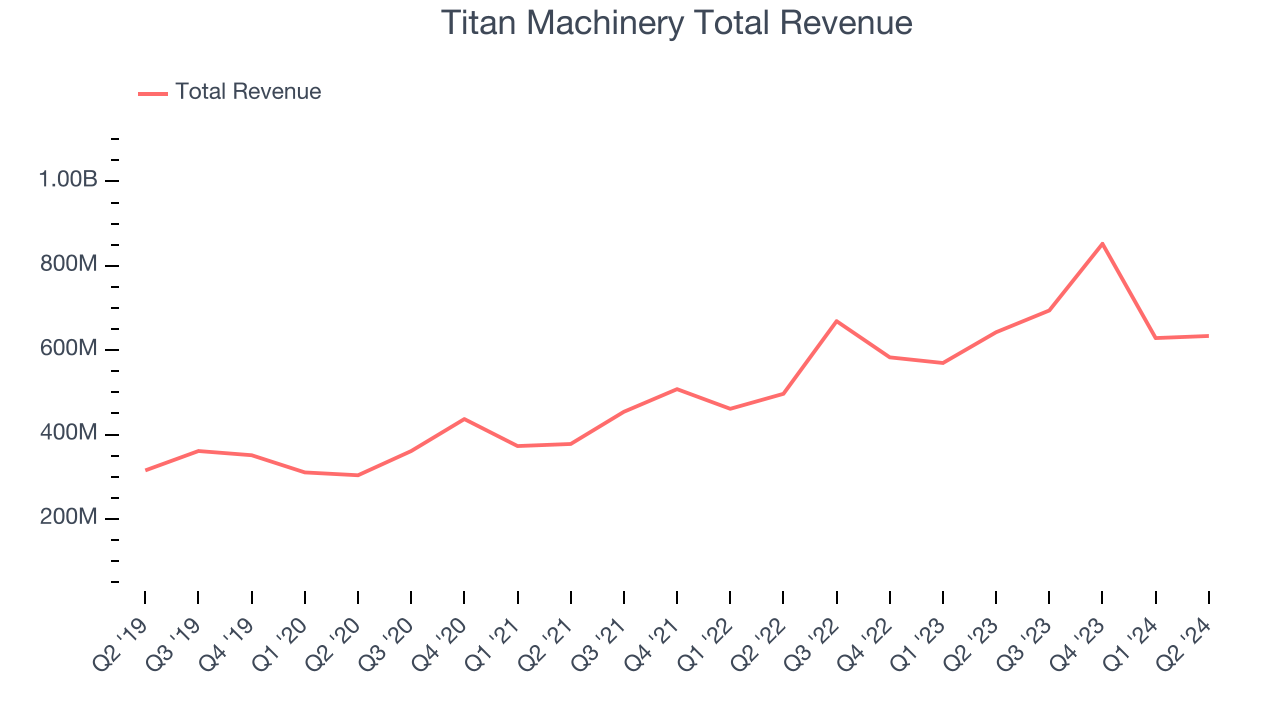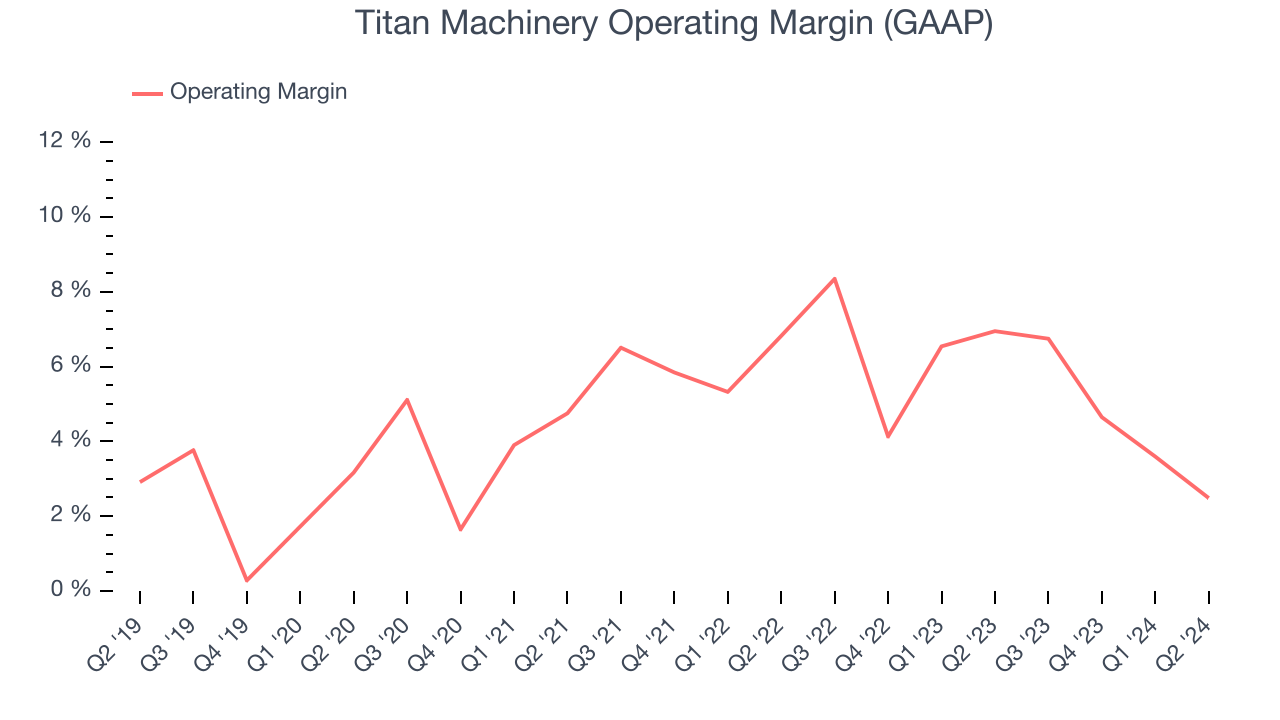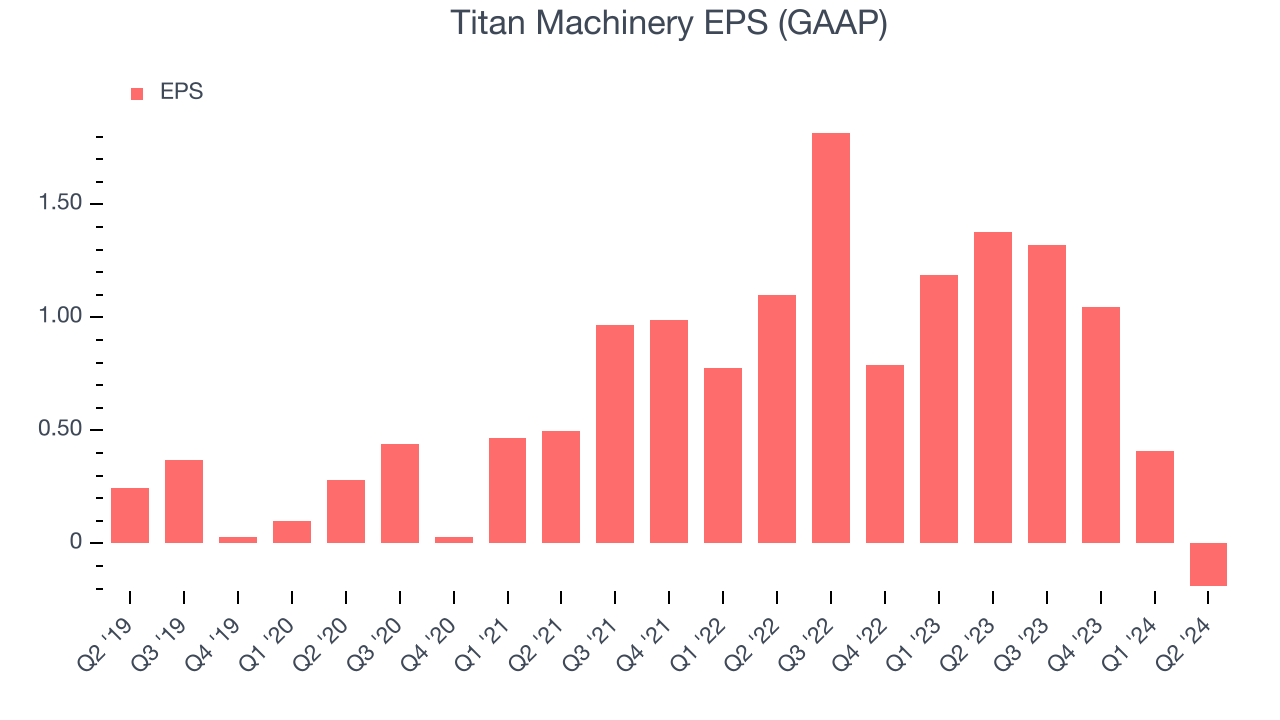Heavy equipment distributor Titan Machinery (NASDAQ:TITN) reported results in line with analysts’ expectations in Q2 CY2024, with revenue down 1.4% year on year to $633.7 million. It made a GAAP loss of $0.19 per share, down from its profit of $1.38 per share in the same quarter last year.
Is now the time to buy Titan Machinery? Find out by accessing our full research report, it’s free.
Titan Machinery (TITN) Q2 CY2024 Highlights:
- Revenue: $633.7 million vs analyst estimates of $634.1 million (small miss)
- EPS: -$0.19 vs analyst expectations of -$0.19 (in line)
- Gross Margin (GAAP): 17.7%, down from 20.8% in the same quarter last year
- EBITDA Margin: 3.2%, down from 7% in the same quarter last year
- Free Cash Flow was -$23.82 million compared to -$62.1 million in the same quarter last year
- Market Capitalization: $317.7 million
"As previously announced, our second quarter results reflect the challenging market conditions that are impacting farmer sentiment and agriculture equipment sales," commented Bryan Knutson, Titan Machinery's President and Chief Executive Officer.
Founded in 1980, Titan Machinery (NASDAQ:TITN) is a distributor of agricultural and construction equipment across the United States and Europe.
Specialty Equipment Distributors
Historically, specialty equipment distributors have boasted deep selection and expertise in sometimes narrow areas like single-use packaging or unique lighting equipment. Additionally, the industry has evolved to include more automated industrial equipment and machinery over the last decade, driving efficiencies and enabling valuable data collection. Specialty equipment distributors whose offerings keep up with these trends can take share in a still-fragmented market, but like the broader industrials sector, this space is at the whim of economic cycles that impact the capital spending and manufacturing propelling industry volumes.
Sales Growth
Reviewing a company’s long-term performance can reveal insights into its business quality. Any business can have short-term success, but a top-tier one tends to sustain growth for years. Luckily, Titan Machinery’s sales grew at an incredible 17.3% compounded annual growth rate over the last five years. This shows it expanded quickly, a useful starting point for our analysis. 
Long-term growth is the most important, but within industrials, a half-decade historical view may miss new industry trends or demand cycles. Titan Machinery’s annualized revenue growth of 21% over the last two years is above its five-year trend, suggesting its demand was strong and recently accelerated.
This quarter, Titan Machinery reported a rather uninspiring 1.4% year-on-year revenue decline to $633.7 million of revenue, in line with Wall Street’s estimates. Looking ahead, Wall Street expects revenue to decline 7.7% over the next 12 months, a deceleration from this quarter.
Today’s young investors won’t have read the timeless lessons in Gorilla Game: Picking Winners In High Technology because it was written more than 20 years ago when Microsoft and Apple were first establishing their supremacy. But if we apply the same principles, then enterprise software stocks leveraging their own generative AI capabilities may well be the Gorillas of the future. So, in that spirit, we are excited to present our Special Free Report on a profitable, fast-growing enterprise software stock that is already riding the automation wave and looking to catch the generative AI next.
Operating Margin
Operating margin is one of the best measures of profitability because it tells us how much money a company takes home after procuring and manufacturing its products, marketing and selling them, and, most importantly, keeping them relevant through research and development.
Titan Machinery was profitable over the last five years but held back by its large expense base. It demonstrated paltry profitability for an industrials business, producing an average operating margin of 4.9%. This result isn’t too surprising given its low gross margin as a starting point.
On the bright side, Titan Machinery’s annual operating margin rose by 2.2 percentage points over the last five years, as its sales growth gave it operating leverage

In Q2, Titan Machinery generated an operating profit margin of 2.5%, down 4.5 percentage points year on year. Since Titan Machinery’s operating margin decreased more than its gross margin, we can assume the company was recently less efficient because expenses such as sales, marketing, R&D, and administrative overhead increased.
EPS
Analyzing long-term revenue trends tells us about a company’s historical growth, but the long-term change in its earnings per share (EPS) points to the profitability of that growth–for example, a company could inflate its sales through excessive spending on advertising and promotions.
Titan Machinery’s EPS grew at an astounding 58.4% compounded annual growth rate over the last five years, higher than its 17.3% annualized revenue growth. This tells us the company became more profitable as it expanded.

We can take a deeper look into Titan Machinery’s earnings to better understand the drivers of its performance. As we mentioned earlier, Titan Machinery’s operating margin declined this quarter but expanded by 2.2 percentage points over the last five years. This was the most relevant factor (aside from the revenue impact) behind its higher earnings; taxes and interest expenses can also affect EPS but don’t tell us as much about a company’s fundamentals.
Like with revenue, we also analyze EPS over a shorter period to see if we are missing a change in the business. For Titan Machinery, its two-year annual EPS declines of 17.8% show its recent history was to blame for its underperformance over the last five years. We hope Titan Machinery can return to earnings growth in the future.
In Q2, Titan Machinery reported EPS at negative $0.19, down from $1.38 in the same quarter last year. This print was close to analysts’ estimates. Over the next 12 months, Wall Street expects Titan Machinery to perform poorly. Analysts are projecting its EPS of $2.59 in the last year to invert to negative $1.23.
Key Takeaways from Titan Machinery’s Q2 Results
We struggled to find many strong positives in these results as its revenue and EPS were pretty much in line with expectations. The market was likely expecting more, and the stock traded down 3% to $13.75 immediately following the results.
So should you invest in Titan Machinery right now? When making that decision, it’s important to consider its valuation, business qualities, as well as what has happened in the latest quarter. We cover that in our actionable full research report which you can read here, it’s free.
